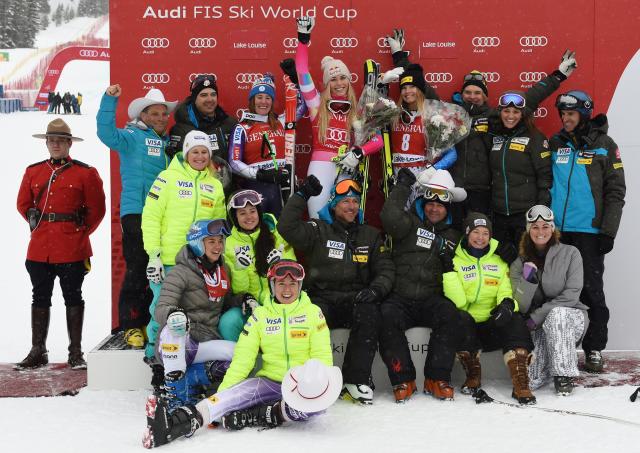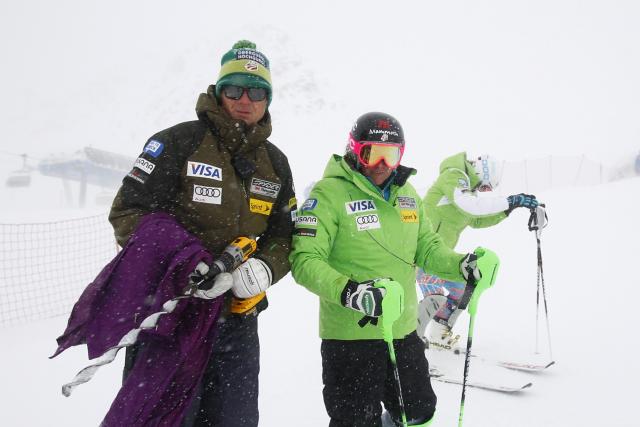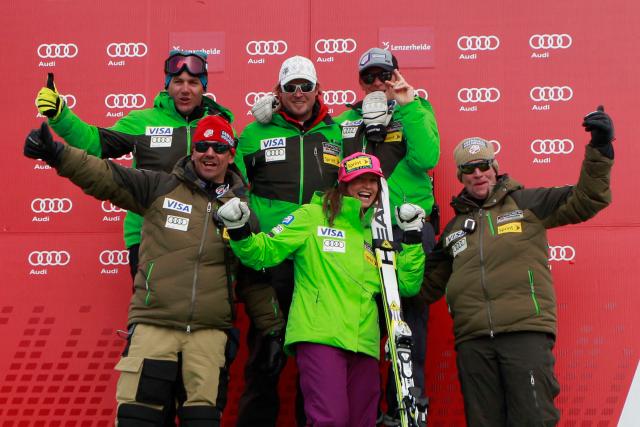From local ski hills to the PyeongChang Olympics, the U.S. Ski and Snowboard Association (USSA) encompasses all athletes that share a passion for skiing and snowboarding. We explore what makes each skier and rider a champion with stories from the U.S. Ski Team, U.S. Snowboarding and U.S. Freeskiing, next to kids winning a NASTAR medal, landing their first cork 7 or joining a club team. Alongside USSA’s mascot Champ, take a look at how all of these athletes strive to be Best in the World.
As we continue to explore what makes USSA athletes champions, we’re learning more than we ever expected. To be a champion is holistic – it goes beyond the medals and the titles. It’s someone with great character and an undying belief in themselves; it’s someone who loves their sport with an unmatched passion—whether they’re still actively pursuing it or not. We are honored to share these stories with you. In this installation, Alpine Press Officer Megan Harrod sits down with the first non-athlete of the series, U.S. Alpine Ski Team women’s speed assistant coach Chris Knight, to discuss #WhatMakesAChamp.
In a world saturated with European ski coaches, it may seem unlikely for the U.S. Ski Team to boast even one Kiwi coach on their roster, but the Team has been blessed with two. Kiwis Chris “CK” Knight and Martin Gray, both hailing from New Zealand, work with the women’s speed team. As the women’s speed team heads down under for their first on-snow camp of the season, we caught up with Knight to chat about his tenure with the team and get his thoughts on what makes a champion.

Knight celebrates a women's podium sweep at Lake Louise in December 2014 – Lindsey Vonn first, Stacey Cook second and Julia Mancuso third. (Getty Images-Mark Ralston)
Not only is Knight an assistant coach for the women’s speed team, but he also works directly with the winningest female alpine ski racer in history, Lindsey Vonn (Vail, CO). In fact, Knight has worked with Vonn in what might be the most impressive two seasons of her ski racing career: coming back from injuries to become the best female alpine ski racer, amassing 17 victories and breaking countless records—including grabbing her eighth World Cup downhill title and becoming the first skier in history to have won 20 crystal globes. Knight gives credit where credit is due, though. It’s not about him. It’s about the athletes.
What’s it like to coach the best female alpine ski racer in history? “LV’s knowledge of her sport is incredible and she knows what she needs to achieve every training day and how to go about it,” said Knight. Being a part of that is energizing, but with it also comes challenges. That’s the nature of a sport that can be affected by a number of variables.
“We have to be 100 percent prepared each day and ready for any challenges that might arise,” said Knight. “We’re often challenged as coaches with schedule, weather, travel times and delays and keeping things running smoothly behind the scenes is especially important. Most energizing and rewarding is knowing something you did helped get a result.”

Knight stands with Stacey Cook on a cold day in St. Moritz. (Getty Images-Mitch Gunn)
Knight himself grew up ski racing in New Zealand, and ski instructed in the U.S. during his university holidays from New Zealand. From there, coaching was a natural progression for Knight and he enjoyed it from the beginning. Before the U.S. Ski Team, Knight coached Austrialia’s Zali Steggall, who won an Olympic bronze in slalom in Nagano in 1998 and a World Championship gold in slalom in Vail in 1999. His coaching career continued with Great Britain’s Chemmy Alcott before joining the U.S. Ski Team in 2003 at the Europa Cup level.
Having lived and worked in the United States with the U.S. Ski Team for the past 13 years at various levels – from Europa Cup to women’s tech head coach and now on the women’s speed side – Knight brings a holistic perspective to the sport with consistency and continuity that is highly appreciated by his staff and athletes. His early experiences with Steggall and Alcott helped him to understand coaching at the World Cup level and aided him in creating a firm foundation for what has been a successful coaching career.
“My first coaching experiences were with athletes who were quite demanding and had high expectations,” reflected Knight. “This definitely helped me realize quickly what was needed to coach at that level. Professionalism and an extensive knowledge of the sport are critical.”

Knight celebrates with Julia Mancuso after the speed team took second in the overall World Cup in 2014. (U.S. Ski Team-Mitch Gunn)
Knight is one of the most seasoned U.S. Ski Team coaches on the women’s side and has learned more than a thing or two about life on the White Circus during his tenure—like, for instance, that the odds are stacked against non-European teams due to a majority of the World Cup races being scheduled on European soil.
“The success of our athletes is even more special because we’re not on home soil,” notes Knight. “You have to spend months away from home in hotels and foreign countries. Being able to adapt to different cultures and lifestyles is critical to success. Listening to the European athletes and staff complain because they have to spend three weeks in America/Canada or the southern hemisphere makes me laugh because if you want a truly global sport it needs to succeed globally, not just in the Alps. Being able to adapt to challenges is very important.”
Starting this week, the women’s speed and tech teams will travel to three different ski areas in New Zealand for training – Roundhill, Ohau and Coronet Peak. Knight plays an integral role in making this happen. Training in New Zealand is unique for the athletes’ first on-snow prep camp because it gives them the opportunity to get in low-altitude, high-volume training. This means athletes are able to get their groove back after a significant amount of time spent off-snow and in the gym during their strength and conditioning camps.
New Zealand also offers off-snow activities that differ from Chile, and simultaneously gives Knight a little taste of home, “There is also a lot to do after training on snow, it is incredibly beautiful and I think everyone is usually pretty excited to go to NZ for training. It’s also great for my friends and family to actually see what I do once in a while.”
Ski racing in New Zealand, much like in the United States, is different – you don’t grow up with it on your doorstep like the Europeans do. From Knight’s perspective, it’s even more of a niche sport in New Zealand than the U.S. “It is easier to stay connected to your job without any distractions and the highs and lows are easier to deal with,” said Knight. “I don’t read foreign newspapers or websites or watch the sports news when I am on the road so I can stay ‘disconnected’ from the distractions.”
Knight is professional, humble and focused on the athletes and their success, as any successful coach should be. How does the coach of the winningest female alpine ski racer in history define a “champion”? Let’s see…
U.S. SKI TEAM: In your words, what makes a champion?
Chris Knight: A champion is an athlete that can overcome odds that defy expectations. They can push harder and longer, have a true mental edge over others and just don’t give up. All the big champions of our sport push the barriers to success every year, raising the bar of performance all the time. They never rest on their laurels and use disappointment as motivation to succeed again.
U.S. SKI TEAM: If you had one piece of advice for an aspiring coach about what it takes to coach a champion, what would your advice be?
CK: You are there for the athlete. Leave your ego at the door.
---
Now, we want to hear your answers! Tell us what makes you a champion on Facebook, Twitter or Instagram and include #WhatMakesAChamp.
